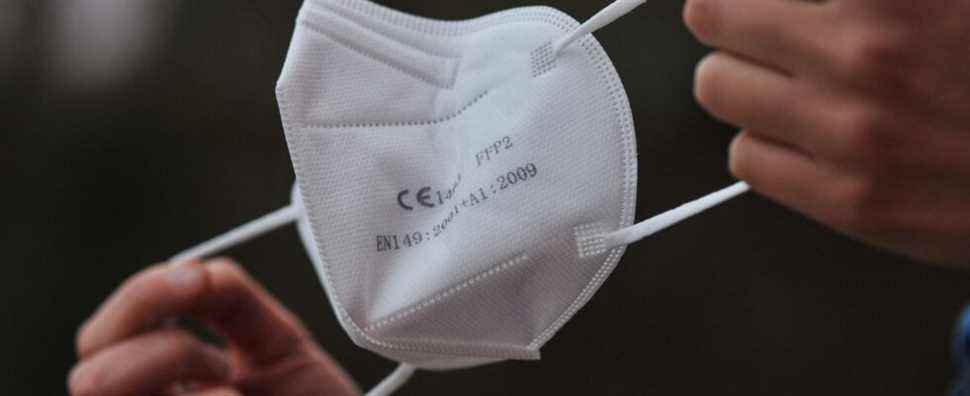Faced with the surge of the Omicron variant and the record incidence rates never recorded since the start of the pandemic, some countries have decided to impose the wearing of the FFP2 mask in public places. This is the case in Italy, where these masks, generally white and shaped like a duckbill, have been compulsory since December 25 in all public transport, cinemas, theaters, museums and stadiums. Same obligation in Greece in public places from January 3. They have also been recommended for almost a year in Austria and Germany, particularly in Bavaria.
>> Covid-19: find all the information on the pandemic in our direct
But if, unlike France, all these countries have decided to impose the FFP2 mask, it is above all because it is more filtering and therefore much more protective than the classic surgical mask. According to several studies published in the scientific journal Nature (PDF, in English), the FFP2 – provided you are well adjusted – divides the risk of contamination by 10 and the surgical mask by only 3.5. And according to the National Research and Safety Institute (INRS), it can be worn for eight hours, the average duration of a working day, against only four hours for the other models.
Franceinfo explains why, despite its significant advantages, the FFP2 mask has not yet been chosen by the government to try to curb the circulation of the virus..
Because it is more expensive than a conventional surgical mask
The FFP2 protects as well the respiratory tract of its wearer than those of those around it. Composed of a facepiece and a filtration device, it offers its users a filtering capacity of 94% of fine and toxic particles of 0.6 micrometers. According to a study (in English) researchers from the universities of Göttingen (Germany) and Cornell (United States), if two individuals wear a correctly positioned FFP2 mask, the maximum risk of contamination between them is only 0.4% … against 30% for two people wearing classic masks. “It is more airtight, and obviously, it has less tendency to go down below the nose.“, confirmed at France 2, Professor Gilles Pialoux, head of the infectious diseases department at Tenon hospital.
But this efficiency, thanks to this unparalleled level of filtration against the virus, comes at a price. Individually, an FFP2 mask is up to six times more expensive than a conventional surgical mask. It takes around 50 to 60 cents per FFP2 mask for an individual and between 30 and 40 cents for wholesale orders from healthcare professionals.
Because imposing it could become an unpopular measure
If for the moment the government has decided to leave the freedom to the regional prefects to impose or not the wearing of the mask of their choice in the street, as is now the case in Paris and Lyon in particular, to require the FFP2 mask in all places open to the public could be seen as a liberticidal measure.
For this new restriction to be accepted smoothly by the population, the executive would probably have no other choice than to offer it free of charge, at the entrance to the places concerned, for example. In any case, this is the opinion of epidemiologist Antoine Flahault. “Like the FFP2 mask est more expensive than the others, if the government recommended it, it would risk having to offer it free of charge in cases where it would be required and that might not excite it, and in any case not hasten its decision “, he confirms to The Express.
Unless with the resurgence of the epidemic, especially since Christmas, the government decides to change its mind. The executive has been relying for a year on the all-vaccine strategy, combined with strict compliance with barrier gestures, but if the contaminations curve were to reverse in the countries which have opted for wearing the FFP2 mask, it would undoubtedly be well obliged to review his copy.
Because out-of-stock cannot be ruled out
If the government communicates little about the FFP2 mask, despite the recommendations of the Scientific Council for this filtering model to be worn by “the most fragile or unvaccinated people, as soon as possible”, it is also because stocks are currently not sufficient.
The French authorities currently have 600 million FFP2 masks. A quantity which could quickly turn out to be insufficient if these filtering masks were to be finally imposed by the government and this even if the local industrialists – now numbering 32, against 4 at the start of the health crisis – assure to be able to produce them. 20 to 25 million per week, according to France 2.
The production of FFP2 masks was almost stopped between April and October, “with a drop in production of around 90%” compared to 2020, underlines Christian Curel, the president of the union of the manufacturers of masks F2M on BFMTV. The number of jobs in the sector, estimated at 10,000, has even been “divided by two”, especially in the face of Chinese competition.
Because there is doubt about the toxicity of some FFP2 masks
FFP2 masks containing graphene, a material widely used in electronics for its resistance and conductivity, should be avoided as a precaution. In the absence of data on the toxicity of this synthetic material, the health security agency Anses ruled, on December 14, that there was a “lack of information on the graphene used by manufacturers and on the toxicity of this substance, in particular in the long term”.
In April, Canada was the first country to withdraw as a precaution, and then to re-authorize, graphene masks manufactured by Chinese company Shandong Shengquan New Materials Co., suspected of causing lung problems. France did the same in June by advising against the use of these same masks.
In an information note published on May 25, Public Health France had even asked “to no longer use” FFP2 masks labeled “Biomass Graphene”.
